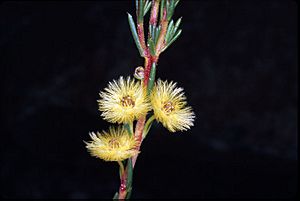Claw featherflower facts for kids
Quick facts for kids Claw featherflower |
|
|---|---|
 |
|
 |
|
| Scientific classification | |
| Genus: |
Verticordia
|
| Species: |
grandiflora
|
The Claw featherflower (scientific name: Verticordia grandiflora) is a special type of flowering plant. It's also known as the clawed featherflower or horned featherflower. This plant belongs to the myrtle family, called Myrtaceae. You can only find it growing naturally in the south-west part of Western Australia.
This plant is a small, stiff bush with many short branches. It has mostly long, thin leaves. Its yellow flowers are quite large for its type. They turn reddish as they get older. The Claw featherflower looks a lot like other plants in the Verticordia group. Sometimes, people get them mixed up.
Contents
What Does the Claw Featherflower Look Like?
The Claw featherflower is a strong, stiff bush. It usually grows about 20 to 70 centimeters (8 to 28 inches) tall. It can spread out 10 to 50 centimeters (4 to 20 inches wide). This bush has one main stem at the bottom. Many short branches grow from this stem.
Leaves and Flowers
The leaves of this plant are long and thin. They are almost like a triangle or circle if you cut them in half. Each leaf is about 7 to 13 millimeters (0.3 to 0.5 inches) long. They have a rounded tip. The leaves closer to the flowers are a bit wider.
The flowers have a nice smell. They grow in round groups near the ends of the branches. Each flower sits on a stalk that is 10 to 25 millimeters (0.4 to 1 inch) long. The base of the flower, called the floral cup, is about 2.5 to 3.5 millimeters (0.1 to 0.14 inches) long. It's smooth and a bit bumpy on the bottom.
The sepals, which are like small leaves protecting the flower, are lemon-yellow or golden-yellow. They quickly change to pinkish-red or reddish-grey as they age. These sepals spread out and are about 5 to 6.5 millimeters (0.2 to 0.26 inches) long. They have many tiny, hairy parts. The petals are the same color as the sepals. They also spread out and are about 4.5 to 6 millimeters (0.18 to 0.24 inches) long. They have long, pointed, finger-like parts. The tips of the stamens (the parts that make pollen) have two horn-like shapes. The style, which is part of the female flower, is straight and about 1 millimeter (0.04 inches) long.
When Does it Bloom?
The Claw featherflower blooms from August to December. You can tell this plant apart from similar ones by where it grows. It also has those special horn-like parts on its stamens.
How Was it Named?
The Claw featherflower was first officially described in 1839. A scientist named Stephan Endlicher wrote about it. He published his description in a book called Stirpium Australasicarum Herbarii Hugeliani Decades Tres. The plants he studied were collected by John Septimus Roe.
The scientific name grandiflora comes from Latin words. Grandis means "large," and -florus means "-flowered." This name was chosen because its flowers were among the biggest known Verticordia species at that time.
In 1991, another scientist named Alex George studied the Verticordia group. He placed the Claw featherflower into a smaller group called Chrysoma. This group also includes V. nobilis and V. rutilastra.
Where Does the Claw Featherflower Grow?
This plant usually grows in deep sand. Sometimes, you can also find it in gravelly soil on hillsides. It likes to grow in heath shrubland and woodlands. It is found widely in the far south-west corner of Western Australia. You can see it from Pingelly in the north down to Corrigin, Lake King, and Ravensthorpe. There's also a separate group of them near Norseman. It lives in several different natural areas, including the Avon Wheatbelt and Esperance Plains.
Is it Protected?
The Western Australian Government's Department of Parks and Wildlife says that Verticordia grandiflora is "not threatened." This means it is not currently in danger of disappearing.
Growing Claw Featherflower in Gardens
The large, colorful flowers of the Claw featherflower make it a popular plant for gardens. People grow it even in eastern Australia. However, it can sometimes get plant diseases caused by fungi. It needs a sunny spot with soil that drains water well. Gardeners usually grow new plants from cuttings. This is because it's hard to find good seeds from this plant.

